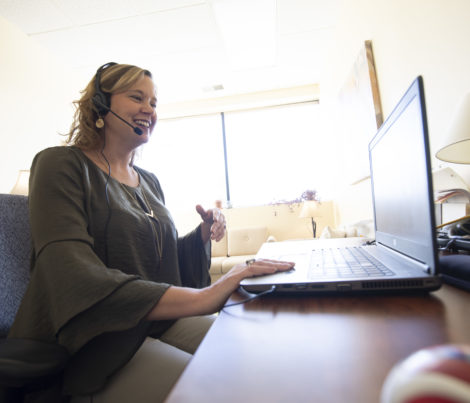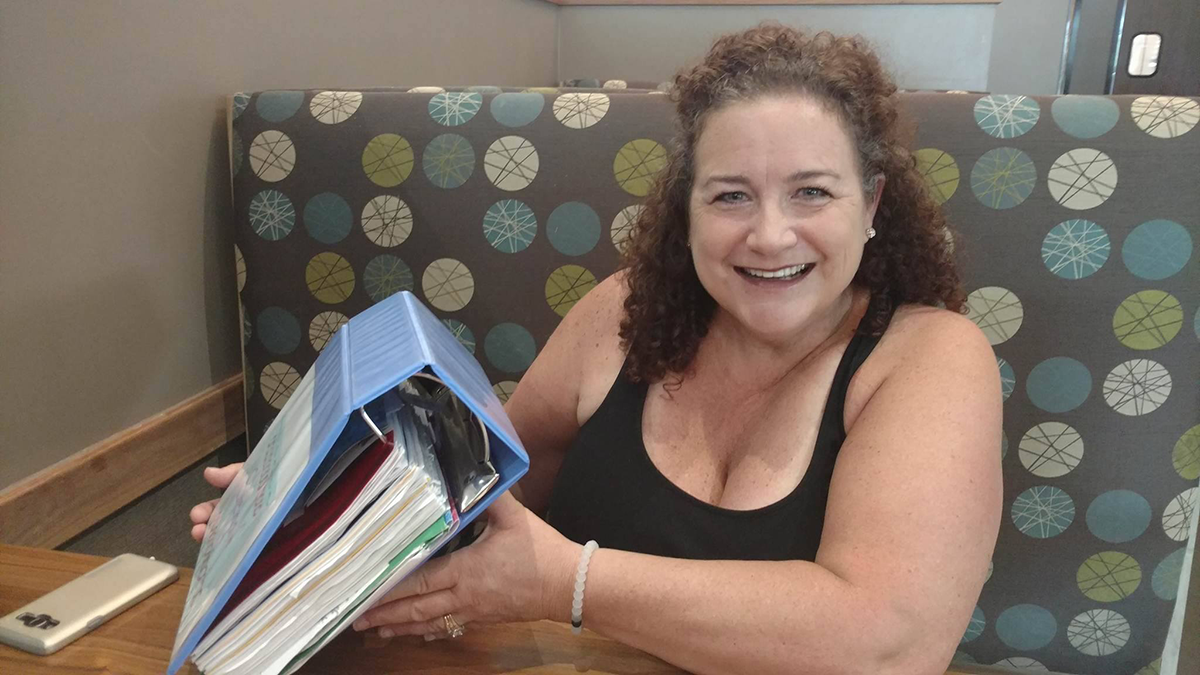
Canvas Health recently welcomed Allison Fredrickson as a new member of its Board of Directors.
As a member of the Board of Directors, Fredrickson will work to maintain awareness of the current challenges and opportunities facing the organization, and will provide support for the organization’s strategic plan and development initiatives.
Fredrickson is an attorney in Eckberg Lammers, P.C.’s Family Law group and a Qualified Neutral with the State of Minnesota. With over thirteen years of experience as a practicing attorney in the family law field, she has dealt with highly emotional and personal legal issues facing families in times of change, including cases that require mediation and courtroom settings. She also handles municipal prosecution for several counties in the metro area, where she is able to use her knowledge of substance and mental health issues to provide just results.
Aside from her focus in Family Law, Fredrickson also has experience in Criminal Law. Prior to joining Eckberg Lammers, she was an attorney with Dudley & Smith, P.A. in St. Paul, MN.
Fredrickson is an active member of Lawyers Concerned for Lawyers, a non-profit organization that educates the public, lawyers, judges and law students in the areas of addiction and mental health. This knowledge and work in the community helps her deal with the issues facing many of her clients.
Fredrickson is committed to community service and outreach, particularly in areas of juvenile and youth services. She is a mentor to youth in the Boy Scouts of America organization and is also actively involved in the Minnesota State Bar Association’s Mock Trial program.
“My affinity for Canvas Health’s mission arises from having witnessed first-hand the unmet need for affordable, accessible mental health services in Minnesota. We are fortunate here to have a wide, well-developed safety net for vulnerable citizens and it is our duty to maintain and enhance it for future generations,” said Fredrickson.

Canvas Health recently welcomed Allison Fredrickson as a new member of its Board of Directors. As a member of the Board of Directors, Fredrickson will work to maintain awareness of the current challenges and opportunities facing the organization, and will provide support for the organization’s strategic plan and development initiatives. Meet Allison Fredrickson Fredrickson is […]
In 2018 Canvas Health launched a pilot for telehealth—a new way for clients to meet with their providers through an app and the camera on their computer, tablet, or smartphone.
After an assessment and initial appointment at a Canvas Health clinic offering telehealth, the clinician and the client can determine whether telehealth would be helpful and desired.

There are a lot of reasons why clients are using telehealth. Clients or kids are sick. The roads are icy. Medical issues prevent them from making their appointment. They moved further away, but want to keep their therapist. They really need to talk to someone immediately.
By far the most common, say Canvas Health clinicians like Megan Chaffee, are ongoing transportation issues. “It’s convenient for clients,” Chaffee says. “And many have challenges getting to the office. They don’t have a car or a convenient bus route or they have health problems, which makes getting around difficult.”
It takes staff a few sessions to get used to providing services this way. They have to get comfortable with the technology and how to explain and coach the app to clients. Plus, it can be harder to read nonverbal cues and it’s awkward at times—especially at the beginning—but a lot of clients like it and, most importantly, it keeps sessions consistent. A 45 minute appointment can take two hours when factoring drive time to and from a clinic. Telehealth saves time and often increases clients’ willingness to commit to therapy.
For Liliana Freire-Bebeau, a Canvas Health psychotherapist in Cottage Grove and Bloomington, it’s given her the flexibility to meet her clients when and where they need her. “It’s like an extra office,” she says. “You still have to do some things face-to-face. I never want to get rid of that…but it does help get clients treatment and keeps them consistent.”
Jay Theisen, Canvas Health’s Director of Outpatient Clinics, has seen this buy-in from other providers once they experience their clients really benefiting. He’d like for all service providers to be able to offer it as a secondary option for those not able to make it into the office. “I hope that clients will soon seek us out because we provide telehealth and can use it to engage more effectively in their recovery.”
As for the future, Canvas Health is still figuring that out. Their providers started using telehealth to provide treatment plan updates and are looking at assessment updates, too. Substance Use Services is starting to use it to provide increased access for clients at schools.
Chaffee is excited about what comes next. “I hope it continues to provide flexibility to clients and clinicians to meet clients where and when they need it. It’d be great if that helps us reach more clients.”
For more information, talk with your Canvas Health therapist or call (651) 777-5222.
In 2018 Canvas Health launched a pilot for telehealth—a new way for clients to meet with their providers through an app and the camera on their computer, tablet, or smartphone. After an assessment and initial appointment at a Canvas Health clinic offering telehealth, the clinician and the client can determine whether telehealth would be helpful […]
April is Sexual Assault Awareness Month (SAAM). The goal of SAAM is to raise public awareness about sexual violence and educate communities on how to prevent it.
The theme of SAAM this year is “I Ask” to empower everyone to put consent into practice. Download information on consent here.
Canvas Health’s Abuse Response Services serves victims of sexual assault and teen relationship abuse in Washington County. The program offers a range of services, including 24-hour telephone crisis response, short-term counseling, 24/7 response to local hospital emergency rooms, support groups, legal advocacy, Safe at Home application assistance and community education. All services are free. If you have experienced a sexual assault or dating violence, call our 24 hour crisis line at (651) 777-1117 or our business office at (651) 251-5079.
April is Sexual Assault Awareness Month (SAAM). The goal of SAAM is to raise public awareness about sexual violence and educate communities on how to prevent it. The theme of SAAM this year is “I Ask” to empower everyone to put consent into practice. Download information on consent here. Canvas Health’s Abuse Response Services serves […]
Canvas Health recently hired Hilke Riechardt-Martinez as its new Chief Financial Officer (CFO).
As Canvas Health’s CFO, Hilke is responsible for all accounting services, financial services, human resources, information technology, property management, procurement, billing and receivables for the parent company as well as all subsidiary companies.
“Hilke brings an understanding and wealth of experience in for-profit and non-profit finances to Canvas Health, as we look to secure our future and deliver on our mission,” said Matt Eastwood, Canvas Health CEO. “Her strong financial leadership will help us continue offering hope, healing, and recovery to the people we serve.”
Hilke has 20 years of leadership experience in the fields of accounting, finance, information technology, and senior management working for Fortune 500 companies as well as five years of experience as CFO of two nonprofit mental health organizations in the Twin Cities.
Hilke completed her undergraduate degree in Accounting at the University of Texas at Austin and her MBA in Finance at the University of Minnesota’s Carlson School of Management. In addition, Hilke holds an active CPA license and is certified as a CMA.

Celebrating 50 years of bringing hope, healing, and recovery to the lives of people we serve, Canvas Health offers over 35 clinic- and community-based programs. Our highly skilled, compassionate clinicians provide services to people struggling with mental illness, substance abuse, crisis, unstable housing, and trauma. As a nonprofit community-based agency, Canvas Health acts as a safety net provider, serving those with complex needs who may not otherwise be able to afford care. For more information, visit www.CanvasHealth.org.
Canvas Health recently hired Hilke Riechardt-Martinez as its new Chief Financial Officer.
Game Day is a free event and all ages are welcome to join. Come enjoy snacks and board games with our NAMI Washington County volunteers. We will provide a variety of board games and card games, but you are welcome to bring your favorite games to share as well!
Event Details:
Date: Sunday, Jan. 20, 2019
Time: 3-6 p.m.
Location: Trinity Lutheran Church; 115 N. 4th St.; Stillwater, MN 55082
NAMI is partnering with Canvas Health for this event; both organizations will have a staffed table with local resources and informational handouts. Through this event we hope to encourage community involvement and acceptance of mental illness.
For more information, call 651-645-2948 ext. 118
email: affiliates@namimn.org
Game Day is a free event and all ages are welcome to join. Come enjoy snacks and board games with our NAMI Washington County volunteers. We will provide a variety of board games and card games, but you are welcome to bring your favorite games to share as well! Event Details: Date: Sunday, Jan. 20, […]
Canvas Health is proud to offer several group services, including support groups, yoga, day treatment, and symptom management, to address our clients’ specific mental health needs.
Canvas Health is proud to offer several group services, including support groups, yoga, day treatment, and symptom management, to address our clients’ specific mental health needs. Learn more here.
Canvas Health joins several legislators in asking the Minnesota House of Representatives and Minnesota Senate to appropriate funding this session for Crisis Connection, a telephone counseling program that helps triage, stabilize, and assist callers in reaching a place of emotional and physical safety. The legislation, HF501 and SF776, appropriates $969,000 – or just 17 cents per Minnesotan per year – to keep Crisis Connection operational. Without this funding, Crisis Connection will begin shutting down its operations after May 21, 2018. Crisis Connection serves more than 52,000 callers from across Minnesota each year.
“Crisis Connection is a lifeline for thousands of Minnesotans. These are our brothers and sisters, sons and daughters, neighbors and friends – and we all have an interest in keeping this important program running,” said Senator Karin Housley (R-St. Mary’s Point). “Without funding for this life-saving public service, the calls would be routed to already-overburdened law enforcement agencies and emergency rooms. For Minnesotans struggling with mental illness, loneliness, and addiction – and those at risk of harming themselves or others – having access to immediate resources could be the difference between life and death.”
Canvas Health CEO Matt Eastwood explained that until now, the agency has cobbled together funding for the service, which is accessed free-of-charge by callers.
“Even with fundraising and contracts, this service still has run at a significant annual deficit. Crisis Connection is an essential part of our state’s mental health safety net, and it needs sustainable, ongoing funding,” Eastwood said.
For nearly 50 years, counselors at Crisis Connection have offered life-saving support to Minnesotans. The Crisis Connection phone numbers have become a part of the culture of crisis support in the state, and are posted on websites, bulletin boards, and in literature in thousands of schools, mental health clinics, first responder offices, and State and community agencies. Often mental health therapists refer clients to Crisis Connection for after-hours counseling, and a closure would force them to identify an alternative or leave their clients unserved when they are unavailable. Additionally, mental health crisis calls are transferred to Crisis Connection from United Way 211 and 911 call operators. Crisis Connection is the only crisis call center in Minnesota responding to calls to the National Suicide Prevention Lifeline (NSPL).
If Crisis Connection ceases operations due to lack of funding, a person could still receive crisis counseling by calling the NSPL phone number, but these calls will no longer be routed to an organization based in Minnesota and familiar with the resources available within the state. Instead, they would likely be routed to a call center in another state – one less familiar with resources available in Minnesota. A lack of timely, appropriate care could have devastating consequences for a vulnerable person in crisis.
“People in Minnesota benefit greatly from having this service operated locally. Our trained counselors have developed relationships with local emergency responders and mental health providers, which, along with the robust database that we have built, help them efficiently and successfully connect people in crisis to resources that can provide them with the best long-term care,” Eastwood said. “We’re their neighbors, and we understand Minnesota – from the mental health and hospital systems, to the geography, to the nuances of Minnesota conversations.”
——————————
Help save lives! Ask your legislators to support HF501 and SF776 to appropriate 17 cents per Minnesotan, per year for Crisis Connection, a suicide prevention telephone counseling program that helps triage, stabilize, and assist callers in reaching a place of emotional and physical safety. Without this funding, Crisis Connection will be forced to stop serving more than 52,000 Minnesotans per year on May 21, 2018. Find your legislators here: https://www.leg.state.mn.us/leg/faq/faqtoc?id=47
Download a letter template to send to your legislator here.
Make a donation to support Canvas Health/Crisis Connection.
Canvas Health joins several legislators in asking the Minnesota House of Representatives and Minnesota Senate to appropriate funding this session for Crisis Connection, a telephone counseling program that helps triage, stabilize, and assist callers in reaching a place of emotional and physical safety. The legislation, HF501 and SF776, appropriates $969,000 – or just 17 cents […]
Help save lives! Ask your legislators to support HF501 and SF776 to appropriate 17 cents per Minnesotan, per year for Crisis Connection, a suicide prevention telephone counseling program that helps triage, stabilize, and assist callers in reaching a place of emotional and physical safety. Without this funding, Crisis Connection will be forced to stop serving more than 52,000 Minnesotans per year on May 21, 2018. Find your legislators here: https://www.leg.state.mn.us/leg/faq/faqtoc?id=47
Download a letter template to send to your legislator here.
Make a donation to Canvas Health/Crisis Connection here.
Help save lives! Ask your legislators to support HF501 and SF776 to appropriate 17 cents per Minnesotan, per year for Crisis Connection, a suicide prevention telephone counseling program that helps triage, stabilize, and assist callers in reaching a place of emotional and physical safety. Without this funding, Crisis Connection will be forced to stop serving […]
It’s that time of year again: The days are shorter, sunlight is scarce, and the bitter cold weather drives us indoors. For some people, this is an excellent time to hunker down and binge-watch favorite TV shows, but for others, it can be a season that leads to low energy, agitated or depressed mood, overeating, social withdrawal, difficulty concentrating, and changes in sleep patterns.
If you notice a majority of these symptoms that start in the late fall and last through the spring, then you may be suffering from seasonal affective disorder (SAD). SAD is classified as a type of depression that occurs in a seasonal pattern and affects as many as 25 percent of people in the United States, especially those in northern parts of the country.

While the specific cause of SAD is unknown, it is typically linked to factors such as serotonin levels, melatonin levels, family history, and your personal circadian rhythm. Although some of these you cannot change, there are still many things you can do in order to beat the winter blues. We have put together five strategies to combat SAD.
One of the main treatments for SAD is the use of light therapy. The purpose of light therapy is to make up for the loss of natural sunlight during the winter months through specialized light boxes. These light boxes utilize 10,000 lux of cool-white fluorescent light, which is about 20 times stronger than normal inside lighting, to mimic the sun and trick the brain into thinking it is outside. Light therapy is typically advised for 20-60 minutes per day and produces best results when used in the morning hours.
Even on cold and cloudy days, stepping outside and getting exposure to natural sunlight greatly increases serotonin levels in your brain, giving you a boost of the mood-lifting chemical. Recent studies have also found that walking through nature can reduce symptoms of depression, another great reason to bundle up and get outside.
Another thing to try to help fight SAD is exercise. Exercise, especially aerobic exercise, boosts your brain’s levels of serotonin and keeps them elevated for hours following a workout. Exercise is also an excellent way to relieve stress and anxiety, as well as feel good about yourself.
Medications called Selective Serotonin Reuptake Inhibitors (SSRIs) are typically used to treat SAD. These work by altering the way serotonin is absorbed in the brain, increasing how much serotonin is available. As with any medication, there are potential side effects with SSRIs, so it is vital you talk to your doctor about risks and benefits.
Cognitive behavioral therapy (CBT) is a type of psychotherapy that is effective for SAD. Traditional CBT provides strategies to help you identify negative thought patterns and gives you techniques to cope with anxiety and depression. Many people see positive benefits from a combination of talk therapy and medication.
The winter months can be difficult for many people, but particularly for those suffering from SAD. While you can’t change the seasons, you can change how they affect you and ultimately beat the winter blues.
Laura Shiff, who contributed this article, is a freelance copywriter from the Twin Cities who specializes in writing web content for software, tech, and medical companies. In her spare time she can be found reading, chasing her toddler, or searching for the best cheese curds in town.
Think you may be suffering from seasonal affective disorder? Our therapists at Canvas Health can help. Our clinics are conveniently located throughout the Twin Cities. To make an appointment today in Cottage Grove, Forest Lake, North Branch, Oakdale, or Stillwater, call (651) 777-5222 For appointments in Coon Rapids or Richfield, call (612) 676-1604.
It’s that time of year again: The days are shorter, sunlight is scarce, and the bitter cold weather drives us indoors. For some people, this is an excellent time to hunker down and binge-watch favorite TV shows, but for others, it can be a season that leads to low energy, agitated or depressed mood, overeating, […]
When my dog slipped away at the veterinarian’s office on Tuesday, I felt inconsolable, but knew I needed to pull it together. My son would be getting home from kindergarten soon. When I walked in the door, I wanted to appear normal, to talk with him about our pug’s passing almost matter-of-factly, as though death were a natural thing, a new phase, no big deal, and not something that could flatten you.
So I held Mister Tuppence one last time, stroked his fur, breathed in his scent, told him I loved him, and couldn’t stop crying. I let him know he was the best dog in the world (because he was). Then I walked out, sat in my car, and felt his absence. My head pounded, and I felt like throwing up.
 Of course, my son at 5-years-old has keen detective skills. When I walked in the door, he looked at my face, cocked his head, and said, “You’ve been crying. I can tell by your eyes. They’re red and wet. Why have you been crying, Mommy?”
Of course, my son at 5-years-old has keen detective skills. When I walked in the door, he looked at my face, cocked his head, and said, “You’ve been crying. I can tell by your eyes. They’re red and wet. Why have you been crying, Mommy?”
“Did Daddy tell you about Mister Tuppence?” I asked him.
“Yeah, he did,” Charlie said and went back to playing. He told me, not unkindly, that I should go upstairs and be alone if I needed to cry.
And so I went upstairs.
How to talk to children about losing their pet.
That night, I wrote that Facebook post, the one where you tell your friends that your sweet pet has died—the request for consolation. The kind thoughts came pouring in, and I accepted them gratefully, reading all the messages and appreciating them, even though I felt too exhausted to reply.
I’m still processing the death of my little guy, and here’s what I’m learning:
Even though your dog wasn’t a person, he was your family, and his life and death matters. Allow yourself to grieve fully.
If you think it will help, let yourself make that Facebook post, the sappy one that essentially asks your friends to console you. Because they will, and it helps. Loss is a universal, so even if your friends didn’t know your pet, they know the experience. Care and love from your friends always makes it better, even though it can’t take the entirety of the hurt away. And if your friends did know your pet, then a Facebook post can be a really good way to consolidate memories.
Let yourself cycle through memories. The night Mister Tuppence died, I was preoccupied with what was left of him, the empty water dish, his collar and leash (still redolent of his scent), his kennel and dog bed. But when I woke up the next morning at 4 a.m., the memories of his entire life came rushing back. This was a good thing, and also powerful. When I thought about all that he meant to me, I was gasping with tears.
My family was lucky enough to have Mister Tuppence for nearly 16 years, and it floored me to think about all the life events that he had been a sweet, simple part of.
I remember how, in his final days, his doggy dementia had progressed. He would back himself into an odd corner of the house and howl. We would give him food and water, and he would howl; we would let him out, and he would howl; we would pet him, and he would howl. This agitation was new and scary and seemed to happen mostly at night. It reminded me of what my friend Tris, who had worked in nursing homes, had described as “sunsetting,” the agitation that people who have Alzheimer’s or dementia experience particularly once the sun goes down. I Googled to see if that was a thing in dogs. It was.
But I also remember walking him on a leash for the first time, how he bounded forth so quickly, straining the leash, pure energy. Back then, he seemed to always be saying, “Why walk if you can run?” When we let him out of his kennel every morning, he’d run down the stairs so quickly, his back legs seemed to disappear.
 I remember the way he bonded with our first foster child. She was only 10 months old when she came to us, so neither of them had language, per se, but even so, they became fast friends and soon devised a chasing game that gave them both a lot of joy. For one week before she was reunited with her family, that little girl was thrust into a strange environment, but having Mister Tuppence around made her happy and gave her comfort.
I remember the way he bonded with our first foster child. She was only 10 months old when she came to us, so neither of them had language, per se, but even so, they became fast friends and soon devised a chasing game that gave them both a lot of joy. For one week before she was reunited with her family, that little girl was thrust into a strange environment, but having Mister Tuppence around made her happy and gave her comfort.
I remember a cabin trip we took to Grand Marais in 2016. By then, Mister Tuppence was blind and deaf, but he seemed to enjoy the fresh air and large expanse of backyard wilderness as much as we did. One day, I put him out back to do his business, went inside, got distracted, and forgot about him. When I went outside, he was nowhere, and I panicked. We all searched for him, calling for a dog who couldn’t hear his name. I ran into the front yard and there he was, walking along the shoulder of the road. The funny thing was, he wasn’t walking away from the cabin, but toward it, as though he was returning from a great adventure. For the rest of that vacation, we joked, “Where had Tuppence gone? Had he been partying? What was he doing out there?” Even now, my son will ask me, “Remember when Mister Tuppence walked along the road? Where was he?”
All of these memories.
I remember the joy of meeting my little boy for the first time, smelling his puppy breath, holding him in my arms and loving him instantly and fully—knowing we were about to begin a great adventure.
Betsy Taylor, who wrote this story, works at Canvas Health.
Learn more about counseling services at Canvas Health.
When my dog slipped away at the veterinarian’s office on Tuesday, I felt inconsolable, but knew I needed to pull it together. My son would be getting home from kindergarten soon. When I walked in the door, I wanted to appear normal, to talk with him about our pug’s passing almost matter-of-factly, as though death […]
On Dec. 1, 2017, Canvas Health will welcome Deborah A. G. Drabick, PhD, Associate Professor and Director of Graduate Studies in the Department of Psychology at Temple University, to speak at its 25th Annual Conference on Psychotherapy and Mental Health. The conference will be held at the Maplewood Community Center in Maplewood, Minn.
Easily Annoyed or Made Angry: Understanding and Responding to Irritability is an interactive workshop that will provide an overview of the nature of irritability and anger across disorders and developmental periods. Participants will consider the roles that these transdiagnostic symptoms play among a variety of conditions and how contextual factors can exacerbate, maintain, or mitigate irritability and anger. Dr. Drabick will discuss effective, pragmatic, and developmentally appropriate assessment strategies, and interventions that can incorporate assessment results across settings.
Pre-approved CEUs will be available from the Minnesota Boards of Marriage and Family Therapy, Behavioral Health and Therapy, Social Work, and Psychology.
Register for the conference here. Early bird rates are available until Nov. 20, 2017.
On Dec. 1, 2017, Canvas Health will welcome Deborah A. G. Drabick, PhD, Associate Professor and Director of Graduate Studies in the Department of Psychology at Temple University, to speak at its 25th Annual Conference on Psychotherapy and Mental Health. The conference will be held at the Maplewood Community Center in Maplewood, Minn. Easily Annoyed […]
On Aug. 19, 2017, 80-year-old Richard Collen drove his truck into Goodview Park in Wyoming, Minnesota, and parked alongside the silent auction tent. Hitched to the back was a precious load: a 1938 Allis-Chalmers B tractor. Collen, who lives in East Bethel, had restored the vintage tractor in memory of his great-grandson, Tim Hickerson. The young man died by suicide in 2015.
Collen had donated the tractor to the Stomp Out Suicide 5K silent auction. The yearly Stomp Out Suicide event benefits Canvas Health, which operates the suicide prevention phone and text lines for the state of Minnesota and provides mobile crisis counseling for greater metro residents.
Collen’s goal was simple: He wanted his tractor to save lives.
Collen and Hickerson’s shared love of tractors—and that particular 1938 Allis-Chalmers B tractor—dated back to when Hickerson was just a boy.
In 1996, Collen and his young great-grandson first spotted the orange tractor on the side of the road, half buried in mud. “You should buy it,” Hickerson told Collen. “It could be our project.” Hickerson was only 5 then, but he and his great-grandpa already shared a special bond. They liked vehicles and restoration, taking things apart, learning how they worked, and putting them back together again.
When Hickerson passed away at just 21 years old, Collen felt as though a vital part of himself had been removed, never to be replaced.
“He was my buddy,” says Collen.

Buying the tractor and setting about the work of restoring it gave Collen an outlet for his grief. Donating the tractor to the Stomp Out Suicide 5K was his way of helping prevent another family from ever having to experience the loss of a loved one by suicide. Tractors like Collen’s typically fetch between $1,500 and $2,500 at auction, but there were no bids on the day of the event. So he drove the tractor home.
Boyd Huppert of KARE-11 learned about Collen’s donation and aired a “Land of 10,000 Stories” segment about the tractor on his Sept. 19 broadcast.
Chuck Brown of Minnetrista and his wife were sitting in bed watching the 10 o’clock news when Huppert’s story came on. For a few minutes afterward, they sat in silence, too moved to speak. They had lost a dear friend to suicide in May and were still so sad. They hadn’t been able to make sense of any of it.
But buying this tractor, Brown believed, could do some good.
Brown sent an email to Canvas Health, talked with Colleen on the phone, and ultimately purchased the tractor for $2,500. Including the tractor, this year’s Stomp Out Suicide event raised nearly $78,000 to help save lives.
The calls and emails to Canvas Health with inquiries about the tractor began as a trickle and became an outpouring as people shared the segment online. The tractor is sold now, but we hope people will continue to give in memory of Tim Hickerson, and in honor of his great-grandpa, who loved him so much.
The Stomp Out Suicide 5K Walk/Run & Have Fun event was founded by Katie and Sean Haines in memory of their daughter Alissa, who died by suicide at the tender age of 15. The event, which benefits Canvas Health, provides a way for people to remember loved ones and raise money for suicide prevention. Please mark your calendar for next year’s Stomp Out Suicide event, which will take place on Aug. 18, 2018.
On Aug. 19, 2017, 80-year-old Richard Collen drove his truck into Goodview Park in Wyoming, Minnesota, and parked alongside the silent auction tent. Hitched to the back was a precious load: a 1938 Allis-Chalmers B tractor. Colleen’s goal was simple: He wanted his tractor to save lives.
In making her first phone call to Canvas Health, Katy Steigauf, a nurse, finally decided to give herself the same care and attention she’d always given to her patients.

“You are not a good influence on me, and I have decided that my life is worth more than drinking you.”—Canvas Health client Katy Steigauf in a breakup letter to alcohol
Katy Steigauf sits down at the café and orders a carafe of coffee. She’s a night nurse, and caffeine provides that little extra fuel to help her keep going.
As recently as last year, she thought alcohol served a similarly useful function. It helped her blow off steam after a long day at work. It had helped her numb the pain of her dad’s cancer and his death, as well as the everyday stress of raising three kids. And besides, drinking helped her connect with people.
“Alcohol was great for coping with every emotion, whether I was happy, sad, or mad. I could make a justification out of everything,” says Steigauf.
Champagne, especially, did the trick. “I always liked champagne because it’s fun, you could go out and have it with your friends. If they served you a mixed drink, it might be watered down, but champagne always was what it was,” says Steigauf, sipping her coffee. “You opened the bottle, and that’s exactly what you got.”
But by 2016, Steigauf was beginning to worry about her relationship with alcohol. “I would go out to the garage away from my kids and sneak a drink directly from the bottle because that’s how classy I am,” says Steigauf. “I would think to myself, ‘Am I an alcoholic?’”
Things came to a head last October. “Oct. 4 was a Tuesday, so you know, it was Taco Tuesday. And not only was it Taco Tuesday, it was also National Taco Day, so of course, I was drinking,” shrugs Steigauf and laughs.
Normally, Steigauf went on shift at 11 p.m., but she’d forgotten she’d agreed to pick up a few hours for a coworker. She was expected at 7 p.m. instead of 11—not enough time for the effects of the alcohol to wear off. “I thought I could wing it,” remembers Steigauf. “As it turned out, I obviously couldn’t. I shouldn’t have been drinking.”
Steigauf’s boss suspected she was under the influence and asked her to take a sobriety test. Steigauf failed it. “I should have known better,” says Steigauf, who still feels the shame of that day. “I carry the insurance for my family. I had put them at risk.”
Steigauf was put on medical leave. The next day, she found it hard to get out of bed. “I felt like a failure,” says Steigauf. “I felt embarrassed. I felt despair. I wondered, ‘What am I going to do now?’”
On the second day, however, she made the call to Minnesota’s Health Professional Service Program (HPSP). The HPSP, a nursing governance body, mandated 300 hours of intensive substance treatment for Steigauf before she could potentially come back to work.
Steigauf decided that this was it—she would commit herself to quit drinking. She chose Canvas Health because of its proximity to home and its track record of helping people get sober. For nearly 50 years, Canvas Health has provided services to people struggling with substance use, mental illness, crisis, unstable housing, and trauma.
At Canvas Health, Steigauf immediately felt at ease. “The intake person was very understanding and really took the time with me,” says Steigauf. “She told me, ‘This is an illness. Don’t be ashamed of it.’”
Steigauf began having one-on-one sessions with Bob Jones, her Canvas Health counselor, in addition to group meetings. Canvas Health uses a cognitive behavioral approach to treating substance use disorders, asking clients to replace the unhealthy thinking that underlies the drinking with healthier thoughts.
As a nurse, Steigauf had written meticulous notes on her patients, and she approached the work of her sobriety with the same thoroughness.
“Bob started me with a planner from day one,” says Katy, patting the thick notebook beside her. “The purpose is to make us more mindful of how we use our time. First he asked me to document what actually happens in a day. Then he started giving me assignments.”
“I would take notes from each meeting and put it in the binder,” says Steigauf, turning to a page in her notebook. “Here’s a quote from the first night: ‘Many of life’s failures are people who didn’t realize how close they were to success when they gave up.’”
Steigauf and her husband decided to be completely honest with her kids about her drinking and the need to get sober. “The hush thing was what had obviously gotten me into trouble in the first place,” says Steigauf. “I wanted them to feel like they could talk about it openly with me or with their friends.”
Her daughter Abby had been reluctant to attend a family therapy meeting—but she wound up attending all five.
“We have a closer bond now,” says Abby.
Steigauf completed treatment successfully in March, but she still checks in with Jones and attends two support meetings a week. She’s back at work and doing well.
You could say that Steigauf’s life has gone back to normal, but that’s not true—her life is better than before, and it goes deeper than simply not drinking. Through and through, Steigauf feels healed.
“I’m really proud of my mom,” says Abby. “She’s done a good job of staying well.”
To schedule an appointment with a Substance Use Counselor at Canvas Health, or to make a referral, please contact us at 651-777-5222.
In making her first phone call to Canvas Health, Katy Steigauf, a nurse, finally decided to give herself the same care and attention she’d always given to her patients.